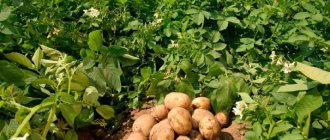Agriculture, largely “thanks” to the crisis, began to actively develop. Many entrepreneurs, having realized the promise of this area, have started their own businesses. Some areas will require significant cash injections. But there are also those that bring high profits with a minimum of investments, take the example of growing garlic as a business.
Knowing the secrets of cultivating garlic, you can reach a high level of sales with little time and financial costs.
Our business assessment:
Starting investments – from 5000 rubles.
Market saturation is average.
The difficulty of starting a business is 5/10.
Garlic growing business is profitable for the following reasons:
- You can even organize your own “plantation” at home.
- Sales are stable, since garlic is in demand both in summer and winter.
- There is not much competition, since few farmers in Russia, Belarus and Ukraine are engaged in growing garlic for sale.
- There is almost a complete lack of investment in business if you have your own land plot.
- Caring for plantings is not difficult.
There is no shortage of garlic on the market, but wholesalers and private traders are always looking for reliable suppliers offering a quality product at a lower price.
Growing garlic on an industrial scale will be profitable only if it becomes a kind of “addition” to an existing farm! But you can’t earn much from selling garlic alone. Therefore, when drawing up a business plan, be sure to calculate the crop yield and think about what other vegetables can be planted in the area.
Legal side of the issue
If you plan to grow garlic at home for sale to friends and relatives, then it hardly makes sense to register your “business” with the tax authorities - sales volumes are not the same. But in the case of an industrial agricultural enterprise, you cannot do without paperwork - this will allow you to cooperate with legal entities in the future. According to the law, growing garlic in open ground will not be considered a business if less than 1 hectare of land is involved!
When registering an individual entrepreneur or LLC, enter the OKVED code 01.13.4 Vegetable root and tuber crops, bulbous vegetable crops.
Private farmers are provided with special “privileges” - reduced taxes. There is a chance to receive a government subsidy to start a business. In order to register the industrial cultivation of garlic for sale in accordance with all the rules and obtain permission from supervisory authorities to conduct business, it will take at least 1 month.
Garlic as a business - profitability
Before starting to implement a business idea, a farmer must decide on the size of production. The plan for growing garlic over a large area involves large investments in mechanization and the purchase of seed material. It will be more profitable for a novice businessman to sow a plant on a small plot of land, which will minimize costs and bring good income.
When creating a business growing garlic, it is important to choose the right planting location:
- farms plant vegetables in open ground. This allows you to harvest a large harvest and get high profits.
- Growing a plant in a greenhouse is not profitable for production. The number of collected heads of garlic is enough only for personal use.
Expert opinion
Alexey Matveev
Expert of our site. An experienced specialist in various fields of agriculture, as well as organizing business processes.
Ask a Question
The area where the spicy plant will grow should be sunny and open. It is not recommended to use land on which cucumbers, carrots, or tomatoes previously grew.
Finding a suitable land plot
The profitability of the business will increase significantly if garlic is grown in a greenhouse on your own plot of land - significant savings on rent.
The rental price will depend on the specific region. In the middle zone, for example, this amount is about 5000/year per 1 hectare of land.
When choosing areas, the agricultural technology of the crop, methods and features of its planting are taken into account. The soil here should be fertile and well drained. Almost all varieties of garlic show excellent growth results in a well-lit area.
Is registration required?
Any business must operate officially. Registration and payment of taxes are required.
Required documents
You need to register as an individual entrepreneur or KFC. It is required to provide documents confirming your identity, a receipt for payment of the state duty and a lease agreement for the land plot.
Recommended tax system
It is better to pay taxes using a simplified form. Activity code – 01.13. It involves paying 6% of income.
You may like: Drawing up a business plan for breeding beef cattle
Are there any field requirements?
Planting is possible both on rented and own land. Renting is possible only after bidding. When organizing a long-term business, it is better to purchase a plot.
Garlic growing technology
When drawing up a business plan for growing garlic, first determine what type of crop you will grow:
- Winter garlic. The best option for entrepreneurs is frost-resistant varieties, high yield, large slices, excellent taste. Planting takes place from late September to late October. Growing winter garlic is more common among agro-industrial enterprises. High-yielding varieties - Lekar, Lyubasha, Polessky, Osenniy, Garkua, Skif, Pluto.
- Spring garlic. The crop is suitable for cultivation only in the southern regions, where the snow completely melts by the beginning of April. In a temperate climate, the ground is still cold at this time - the planting material will not sprout. Growing spring garlic is more suitable for small garden plots. High-yielding varieties - Kledor, Flavor, Elenovsky.
The technology for growing garlic will depend on the selected planting material. The crop does not grow from seeds. Cloves and bulbs are used as them. In this regard, winter crops are “universal” - any planting material will do. Spring garlic can only be grown with cloves.
Whatever growing method is chosen, the technique is as follows:
- Select only high-quality cloves or bulbs. There should be no traces of disease damage on the planting material.
- Planting material is buried 6-7 cm into the ground with the roots down. The distance between specimens is up to 10 cm, and between rows – at least 20 cm.
Specific growing conditions may vary depending on the variety of garlic chosen. But in general, the culture is undemanding. All you need is to regularly water the beds, cut off the arrows that form, remove weeds, loosen the soil, and fertilize the area.
The technology for growing winter garlic involves harvesting 100-120 days after sprouting above the ground. Next, you need to ensure storage of the collected garlic. And what’s good about winter garlic is that it can be stored for a long time under proper conditions. If the weather outside is damp, the garlic is dried indoors.
Let's calculate business costs and profitability of growing garlic
Let's look at a simple business plan for growing garlic and how much you can earn from it. Initial data – a plot of 10 acres owned. Losses on weeding passes will be 10%; the area sown with garlic was 9 acres. We will not buy equipment for growing garlic; we will use a rented cultivator to dig up the soil. The cost of the service is 5,000 rubles.
Seed material – cloves, planting form – winter garlic. The area for sowing is 900 m2, then we will need 900 * 100 = 90,000 grams or 90 kilograms of planting material. The average wholesale cost of garlic in the fall is about 100 - 150 rubles per kilogram. For calculation, we accept 120 rubles per kilogram, we buy 95 kilograms, with a margin. The cost of seeding material will be 11,400 rubles.
Fertilizers should be applied two weeks before planting garlic. Copper sulfate – 1 liter per 1 m2. After applying fertilizer, it is advisable to cover the area with film before sowing the garlic.
After the slices have been selected for planting, it should be disinfected. For this, many people use ash lye: 400 grams of wood ash per 2 liters of water, boil, cool. Selected teeth are placed in this solution for 2 hours. Another way is to use a solution of potassium permanganate. Make a weak solution, 1 teaspoon per 10 liters of water, soak the garlic for 10 hours. Some calcinate the planting material, treat it with copper sulfate and various chemicals.
But no matter how you disinfect the seed before planting in the future, it is better to change it every three to four years and grow it from bulbs (aerial bulbs).
Conventionally, we believe that disinfection of seed material is made from available materials.
We are planning to buy 10 tons of humus for growing garlic, the cost is 10,000 rubles. Other drugs 500 rubles. We will accept other costs as 1000 rubles.
We collect costs: 5,000+11,400+10,000+500+1,000=27,900 rubles.
Land tax – 1,500 rubles. Without taking into account the cost of manual labor of the entrepreneur, the cost of electricity for the pump for watering garlic, the cost of the cost will be 29,400 rubles.
Conventionally, our harvest will be 700 kg, the cost of wholesale sales is 90 rubles, then the revenue can be 63,000 rubles. Profit 35,100 rubles, profitability of growing garlic 55%.
Will special equipment be required?
Growing winter garlic, if we talk about a home business, does not necessarily require mechanized equipment. But experienced gardeners will confirm how difficult it is to cultivate large plots of land. Therefore, for the entire agricultural complex it will be necessary to purchase appropriate equipment.
Machine - “digger” for collecting garlic
This may include:
- mini tractor,
- cultivator,
- watering machine,
- conveyors for sorting crops.
In recent years, industrial cultivation of garlic has become a very profitable production and a profitable investment. But vegetable growers are in no hurry to get involved in the crop, and the main reason for this is the uncertainty of the sales mechanism.
How much starting capital is needed?
To open your own production (for example, let’s take a plot of 1 hectare) you need start-up capital to rent a plot of land, purchase or rent agricultural equipment, wages to workers, purchase planting material, watering plants.
The larger the area to be treated, the higher the start-up costs.
Calculations for starting a garlic business on 1 hectare of cultivated area are given in the table:
| № | Nature of costs | Amount in rubles |
| 1 | Rent of land | 200 000 |
| 2 | Agricultural equipment rental | 80 000 |
| 3 | Buying small garden tools | 30 000 |
| 4 | Purchase of seed material | 100 000 |
| 5 | Paperwork | 10 000 |
| 6 | Purchasing fertilizers | 10 000 |
| 7 | Employee salaries | 60 000 |
| 8 | Tax deduction | 10 000 |
| 9 | other expenses | 10 000 |
| Total: | 510 000 | |
For comparison, expenses per 1 hundred square meters are approximately 44 thousand rubles.
Industrial planting of garlic
Garlic is still a fairly popular crop, so both farms and gardeners are engaged in its cultivation, who can count on profit from their plot.
Important! When planting high-quality seed, the yield can reach 1 ton per 10 acres. Isn't this an incentive to grow garlic as a business?
In industrial plantings, garlic is grown in two ways:
- from teeth;
- from bulbs (aerial bulbs).
The harvest from the cloves is obtained the next year after planting winter varieties of garlic, and in the fall when planting seeds in spring. When planting with bulblets, in the first year they obtain seed material - one-toothed bulbs, which the next year produces a full harvest. Thus, bulblets are seed material for growing garlic in a two-year crop.
Landing
It would be most advisable to plant winter varieties of garlic. It should be planted 40 days before the onset of the first frost. The best time is September-October.
Can be used for planting:
- aerial bulb (arrow bulb);
- sevok (one-toothed onion);
- one clove of the head.
It is recommended to change the seed every 3 years, which avoids the processes of degeneration of garlic varieties. It is better to use sets or one clove of garlic for planting, since the aerial bulb will yield a harvest only after 2 years. The volume of required seed depends on planting density and variety, but is in the range of 600-1,500 kg/ha.
We invite you to watch a video about planting large quantities of garlic:
The Basics of Successful Commercial Garlic Growing
To obtain high yields, you need to study the technology and adhere to it when growing garlic.
- The soil. Her preparation is of utmost importance. The soil is fertilized using compost and humus; fresh manure is not used in growing the crop. Large areas are cultivated with agricultural machinery; if several acres of land are allocated for planting garlic, then it can be cultivated manually.
- Sorting of seed material. Whole heads are disassembled into cloves and sorted by size into three groups: large - more than 1.7 g, medium - 1.1 -1.7 g, and waste. Bulbs are sorted into groups: 6-8 mm in diameter, 4-5 mm, up to 4 mm. Single teeth are sorted into fractions: large - more than 14 mm in diameter, medium - 10-14 mm and small - less than 10 mm.
- Seed treatment. Before planting, the seeds are treated with fungicides, with the addition of a preparation containing microelements. The destruction of nematodes is carried out by aeration with sulfur dioxide in hermetically sealed containers.
Where to start - step-by-step plan
Think about and plan every action. A calendar plan will help you with this. By regularly checking the schedule, you will receive your first income in the minimum time allowed by production technology.
Example of a calendar plan:
| Works | 1 month | 2 month | 3 month | 4 month | 5 month |
| Registration | |||||
| Equipment purchase | |||||
| Purchase of material for sowing | |||||
| Hiring workers | |||||
| Soil preparation | |||||
| Sowing | |||||
| Plant nutrition | |||||
| Cultivation | |||||
| Harvesting | |||||
| Sale |
Let's look at the main steps you need to take to set up a business.
Step 1. Registration and preparation of documents
To earn money from selling garlic, we register as an individual entrepreneur, peasant farm (peasant farm) or LLC. A simplified tax system applies to all these forms.
If you intend to develop a plot of 1 hectare, open an LLC with a simplified taxation system. OKVED code: 01.13 “Growing of vegetables, root and tuber crops, melons, truffles, mushrooms.”
Registration takes about a month on average. You can submit documents to government agencies in person or by registered mail.
Step 2. Site selection and soil preparation
You can start production with a plot of 20 square meters with the prospect of further increasing it. On a small area you will not get a high income, but this is a good field test - determining the quality of the soil and the suitability of the seeds.
Winter garlic loves sandy loam soils with neutral acidity. To determine the acidity of the soil, drop a little vinegar on a lump of soil. If it sizzles, it means the acidity is neutral. It won't hiss - it's high.
It is advisable to choose a flat area without hills, otherwise watering the plants will be uneven. At higher elevations, winds in winter will blow snow, and the crop will freeze. Melt and rainwater will accumulate in the lowlands, and the bulbs will rot.
Dig up the area 2 weeks before planting the seeds. Add compost or humus to the loosened loamy soil. “Feed” clay soil with peat in the amount of a bucket for each square meter. Loams are added to the peat soil by the bucketful. In the sandy one - a bucket of clay and peat for each square meter of the bed.
Step 3. Preparation of planting material
For sowing, select the largest and hardest bulbs. Separate them into cloves. They must be dry, without rot.
Seed planting scheme
Three types of seed are used for planting:
- bulbs and arrows;
- single clove bulbs (not divided into cloves);
- teeth
When planting, keep a distance of 10-15 centimeters between the cloves. There is a distance of 20-25 centimeters between the rows.
Popular varieties: Gribovsky, Otradnensky, Komsomolets, Danilovsky, Poretsky.
Step 4. Recruitment
For a small crop area, two people are enough. At home, you can cope on your own and with the strength of your family members. If you are aiming for large-scale production, you will need hired employees to care for the beds, water and harvest the crops, and sort them.
The average salary of a handyman is 12,000 - 20,000 rubles, depending on the region and the number of working hours.
Step 5. Harvest
If you planted garlic in November-December, it will produce a harvest in June-July. As soon as the green feathers have turned yellow and the lower leaves have dried, it’s time to dig up the heads. Don't wait until the tops dry out completely, otherwise you will leave a lot of bulbs in the ground.
Separate the dug up heads from the tops and scatter them on a flat surface in the shade to dry. Store harvested produce in a cool, dry place, such as a dry basement. It will stay safely until late spring. Plant the sprouted cloves in the ground in the spring. They will produce single-pronged bulbs, from which you will get large bulbs next year.
Dried sorted products are ready for sale.
Industrial planting
Planting with teeth.
In winter, garlic should be well-rooted, with sprouts of 0.5-1.5 cm. To do this, it is planted at the optimal time for the region. Usually at this time the soil temperature drops to 10-12°C. Spring forms are planted in the fall at the same time as winter forms, and in the spring - from the moment field work begins.
Planting with bulbs
. It is done at the same time as cloves are planted, or in early spring. The industrial technology for growing winter garlic uses a non-transplanting method for obtaining a harvest from aerial bulbs. To do this, large and medium fraction bulbs (4-8 mm) are sown in moist soil on July 1-5. By winter, plants have time to form a powerful root system, without forming a bulb. These are single-toothed plants that will produce a full, very high-quality harvest next year.
What is needed to start
Without experience, it is best to start growing garlic for sale in small quantities. On an area of up to 20 acres of land, there will be no need to rent equipment or hire workers.
Covering a large area of land, namely from one to several hectares, the following must be taken into account:
- If it is not possible to rent land and agricultural machinery, we buy the land and replace the equipment with working personnel.
- Select the variety you plan to breed. Garlic does not require careful care, so taking care of the harvest yourself is quite possible.
- The soil needs to be changed every year, crop rotation is necessary.
- Develop a detailed production plan, growing technology and care.
- It is important to immediately determine the place of sale, since the shelf life of garlic is from 3 to 8 months.
- Financial calculation of costs and income. With a large abundance of garlic on the market, there will be competition and low prices.
If you decide to grow garlic constantly and in large volumes, then be prepared for significant investments in seed material. The very next year of doing business, you will be able not to purchase seeds, but to use them from your own harvest. All initial costs depend on the volume of your own business. The table shows the cost amounts per hundred square meters and per hectare.
| Expenses | For one hundred square meters in rubles | Per hectare in rubles |
| Registration and paperwork | 10,000 (one time) | 10,000 (one time) |
| Land lease | 80 | 8,000 (per season) |
| Seed garlic | 3.750 (15 kg for 250 rub.) | 375,000 (1500 kg for 250 rubles) |
| Fertilizers | 200 | 20.000 |
| Agricultural machinery rental | No | 80.000 |
| garden tools | 250 | 25.000 |
| Salaries for hired workers | No | 60.000 |
| Result: | 14.280 | 578.000 |
To grow garlic, you do not need to build greenhouses or other structures; all work is carried out in open ground. This factor significantly reduces the initial budget. However, it is worth remembering that the harvest of garlic heads can only be obtained once a year, so you should take care of the storage conditions for vegetables in advance.
Under favorable weather conditions and fertile soil conditions, you can harvest 500 kilograms per hundred square meters, and from 10 to 50 tons of garlic per hectare.
Calculation of profit: garlic sold at 100 rubles per kilogram gives a profit per hundred square meters - 50,000 thousand rubles, and per hectare - from 1 million rubles. Based on our calculations, we can say that the business will pay off within a year.
Preparation of documents
It is necessary, at your choice, to register your business in the following legal forms: individual entrepreneur, limited liability company or peasant farm.
Individual entrepreneurs and LLCs operate under a simplified taxation system, and farmers operate under a single agricultural tax. The interest rate is the same for everyone, 6% of the income. When registering, you must indicate OKVED code 01.13 “Growing vegetables, fruits, crops for the production of drinks and spices.”
Site selection
A plot of land can be rented or purchased for an agricultural business. Renting one hectare of land will cost you from 4 to 10 thousand rubles. Farmers and peasant farming enterprises who do not have land shares rent land without bidding. Organizations cannot rent land for their own purposes without bidding. For a long period of farming, it is better to buy a plot.
Before planting garlic, it is important not only to choose the right site, but also to prepare the soil. Garlic does not grow well in shady areas. Wet and manured soil is not suitable. When choosing a location, make sure that moisture does not linger there. Check the acidity of the soil.
The site should be located on a hill, allow sunlight to pass through, so that harmful insects do not appear in the soil and the soil does not become sick. For productivity, the soil must be fertilized.
Worker selection
You yourself are an accountant and sales manager. If you plant the plants yourself and do all the work, then you don’t need employees. But in the case of crop rotation and a large volume of work, on several hectares of land, this must be done.
It is not necessary to recruit female assistants with qualifications. It is important to have minimal knowledge: planting, weeding, watering and proper care of garlic.
You will need the services of an agronomist to study the composition of the soil and schedule crop rotation.
For men, there are more serious qualification requirements: certification for the right to drive tractors (category A) and cars (categories B and C). Certification for the right to carry out work on applying fertilizers and using chemical plant protection products.
Equipment and inventory
Equipment can always be rented. Prices are affordable. And if money allows, then buy it. Also, make a well for automatic watering of plants.
Equipment that will be needed for work: rakes, shovels, buckets, hoes, hoes, gloves. Equipment you will need is a seeder, a tractor and a trailed combine.
Industrial cultivation of garlic
- Caring for garlic plantings.
In small areas, they practice mulching and covering plantings for the winter; in the spring, straw and leaves are removed. Large areas are harrowed across the rows in the spring, destroying weeds and providing air access to the roots. - Fertilizing
is done with nitrogen fertilizers when seedlings appear, then when signs of mineral starvation appear.
Watering
- as the soil dries to a level of 70% HB and below. - Removing arrows.
This technique is mandatory; it increases yield by 25-30%. Produced when arrows appear en masse. - Harvesting garlic
. The quality of the product, its presentation and shelf life directly depend on the timing of harvesting. Garlic is harvested in dry weather. They are dried under canopies, in rainy weather - in specially equipped dryers.
Features of care
The amount of harvest directly depends on the care. It is important to adhere to the basic recommendations.
Irrigation
According to growing technology, watering is recommended approximately once a week. Irrigation is reduced in rainy weather. Irrigation is also removed shortly before harvest. After about 3 weeks, irrigation is completely stopped.
Soil treatment
It is important to know that after rains a kind of crust forms on the ground. It needs to be removed. Otherwise, oxygen will not be able to flow normally. It is necessary to carry out shallow loosening. This will improve oxygen access. The main thing is not to damage the seed.
Fertilizer
Nitrogen amendments are recommended early in the season. The procedure is repeated after 2 weeks. During planting, phosphorus-potassium compounds are added. Fertilizers are always applied only after irrigation or rainy weather.
Video
Of course, growing this crop has its own characteristics. For example, removing arrows still requires manual labor. But despite this, the garlic business is still very attractive.
The best industrial varieties of garlic are winter varieties Parus, Lyubasha, Polessky, Skif, German, spring varieties Kledor, Flavor.
A profitable solution if you have land is growing garlic as a business. Food crops are highly valued and popular among consumers. At the same time, there is a demand for garlic throughout the year, and the peak of sales occurs during the canning season. The process of growing crops does not require major investments or special equipment. The business is ideal for beginners and those wishing to receive a quick and stable income.
Today, farmers prefer winter and spring garlic. At the same time, the first one is more in demand and has a large number of advantages:
- high productivity;
- resistance to low temperatures;
- unpretentiousness to climate and soil;
- economic benefit.
Anyone can start growing garlic for sale at home, even without experience or knowledge. It is enough to have a free plot and desire. The variety of winter garlic is determined depending on the weather conditions of the region where planting will take place. The most common are:
- Lyubasha.
Easily tolerates frost and dryness. Can be stored for up to 10 months without loss of quality. The average weight of the bulb is 80-120 grams.
- Ukrainian white and purple.
Two varieties, the weight of the bulbs is 60-140 grams. The varieties do not bolt and produce a good harvest of about 200 kg per 1 hectare of land. Suitable for long-term storage.
- Saved.
It has high keeping quality and productivity. The weight of the bulb is 60-100 grams.
- Messidor.
Dutch variety of winter garlic. The harvest is up to 25 tons per 1 hectare.
- Gulliver.
A mid-late representative of garlic varieties, the mass of the bulb is about 100 grams. It produces good shoots and can be stored for a long time.
- Benefit.
One of the best varieties of garlic, bred in Romania. The culture tolerates frost well and is not picky about weather conditions. It has high productivity, does not get sick and is easy to adapt.
Which of the proposed varieties to choose is up to you. In some regions, large onions with a delicate aroma are preferred, in others small and spicy. You should be guided by the demand at the place of sale, as well as the available capital.
Productivity
Garlic is grown all over the world. The vegetable is used as an addition to many dishes. It can be eaten fresh, as well as pickled, pickled, stewed, and prepared according to other recipes. Before you start growing garlic for sale as a business, you should familiarize yourself with the characteristics of this crop. Gardeners distinguish 2 groups of vegetables:
- Spring. It is planted in early spring. These varieties are small, have dense heads with spicy, but not very sharp, cloves. The storage period for fruits can be up to a year.
- Winter. Planting occurs in mid-autumn. The resulting specimens have large sizes, smooth and beautiful teeth with a rich, pungent taste. The main disadvantage of this type is the short shelf life, which is 3-4 months.
Productivity is always high. Depending on the variety and growing conditions, 100-500 kg are collected from 1 hundred square meters. And per hectare – 10-50 tons. Such indicators lead to high and stable profits. The main thing is to constantly improve your business.
Planting material
High-quality seed material is the key to a good harvest. Since the crop is very susceptible to degeneration, it is almost unsuitable for planting on an industrial scale. However, as a home business, with careful selection of bulbs you can get a good income.
- Bulbs.
Their second name is aerial bulbs. Suitable for planting every other season: in the first season, the onion is sprouted from the cloves, in the second - full-fledged garlic.
- One-toothed.
It grows from an aerial bulb and is the best planting material. Sevok allows you to get garlic with a large head and a large number of cloves.
- Tooth.
Obtained from a mature bulb. Refers to the first reproduction. Serves as good seed material.
It is best to use seed obtained independently. By purchasing through intermediaries, the likelihood of getting a good harvest is significantly reduced. Therefore, after harvesting garlic, you should always leave a bulb or clove for later planting.
On the question of the profitability of industrial cultivation
At first glance, it may seem that growing garlic on an industrial scale is unprofitable and associated with great risk. This opinion is argued by the fact that some other crops, such as wheat or rye, are in great demand and require less care. Let's take a closer look:
- The market for this vegetable crop is quite wide. These are large plants or factories specializing in food products.
- The vegetable market should also not be ignored, where garlic is in great demand. Therefore, small entrepreneurs purchase this product in medium quantities all year round.
- Chains of supermarkets and grocery stores of various sizes also find the product in demand. This part of the industrially grown garlic market is the most profitable, since the pricing policy here is very flexible and there is an opportunity to increase the previously planned profit.
- Not the least platform for selling products is catering and fast food chains: cafes, canteens, restaurants, pie shops, etc. This is a year-round sales market, because this vegetable is necessary for preparing many dishes and snacks.
Garlic is often used in cooking
- Great demand for the product is a guarantee of business profitability. This is a huge plus for an entrepreneur. The second important argument in favor of growing garlic on an industrial scale will be a comparison of its cost with prices, for example, for wheat. For garlic it is much higher, sometimes up to several times.
- An important advantage of cultivating this vegetable is low competition. This makes it possible to dictate your terms in the pricing policy and guarantees the sale of grown products. Whereas grain producers cannot boast of this.
The industrial scale of growing this product is a more complex undertaking than garden selection and requires serious calculations and a well-thought-out business plan. Entrepreneurs who have been engaged in this type of activity for several years now recommend doing without the use of technology in the first stages of business development. This will minimize investments, and hence risks. You should think about additional spending on equipment to make work easier and increase profits later.
Sales channels
The advantages of this business for farmers are:
- high profitability of growing garlic;
- minimal cash investment;
- high demand for products.
For 1 kg of goods you can earn up to 150 rubles in retail sales.
Resellers value garlic at a lower price, but are ready to immediately buy large quantities.
The garlic harvest can be sold not only to retailers and wholesalers. Potential clients are:
- vegetable shops;
- supermarkets;
- restaurants and cafes;
- canneries;
- catering enterprises.
By concluding a supply agreement with a suitable company, you can forever solve the problem of marketing winter garlic. Resellers assume all risks for the further sale of products, and you receive a clean and regular profit.
Consider a garlic growing business. Garlic is a valuable food crop and is used as an additional ingredient in canned food. The product is in demand all year round. Good demand for the product creates favorable conditions for engaging in this business. Next, let's talk about the details and subtleties that you need to know.
Garlic is grown without the use of special agricultural technology, which is optimal for beginning businessmen. The unpretentiousness of the plant allows you to minimize financial costs. If the necessary conditions are created, garlic can be stored for a long time.
At the initial stage, purchase seeds and grow the crop yourself. Purchase equipment that makes your work easier later using the proceeds from the harvest.
Market analysis
The capacity of the Russian garlic market is quite high. For one person, the physiological norm is 0.8 kg/year. In the economic activity of an enterprise, it is important to foresee channels for the sale of manufactured products. At the same time, it is necessary to skillfully develop relationships with buyers and consumers of products, win your market share, and skillfully compete with similar enterprises or intermediaries.
The clients of a garlic growing enterprise will mostly be city residents, as well as wholesalers and retailers. In order for products to be in demand and have high competitiveness, it is necessary to achieve their moderate price with highly competitive quality. Products can be sold in supermarkets, markets and public catering establishments. Wholesale sales are also planned.
Garlic is needed both in fresh form and as a product for processing by canning manufacturers. Those, in turn, are only increasing the turnover of their products every year. Canning factories make big claims about the quality of Chinese garlic, since when growing it they use chemicals that not only negatively affect the quality of the mature product, but are also prohibited throughout the world.
In addition, Russia has developed a special program to support domestic producers, which takes part in financing such projects. This happens through investments in special equipment for planting and harvesting garlic and the purchase of high-quality varietal material.
Selection of planting material: cultivation technology
Types of planting material:
- Bulbs obtained from the arrow (aerial bulbs). From them grow bulbs with one clove - planting material for next year.
- Bulbs with one clove (odnozubka, set) - grow from aerial bulbs. The best planting material, planted sets produce a large head of garlic with a large number of cloves.
- Teeth from mature bulbs of the head (first reproduction) are also good seed material.
If a head of garlic has no more than 4 cloves (even large ones), then it is degenerate garlic. If these cloves are planted, the harvest will be weak.
To obtain high-quality planting material, grow aerial bulbs, of which single-toothed bulbs. Teeth from the heads of the first reproduction also give a good harvest. Leave some of the plants for seeding in the future.
Landing technology
First, the soil is prepared. It is usually fertilized with humus or compost (without using fresh manure). Next, the planting material is sorted. The whole head is divided into cloves, which are divided into different size fractions. Next, each fraction is planted at a certain distance: small fraction - 5–6 cm; Medium – 10 cm; Large – 15 cm.
Garlic varieties that can be grown
The table below shows the most popular crops that can be grown in Russia and Ukraine.
In addition to the above, the following varieties of garlic are popular in Russia:
- "Komsomolets"
- "Otradnensky"
- "Gribovsky Jubilee"
- "Poretsky"
- "Danilovsky local"
Growing garlic - problem and solution
You can find garlic in almost any peasant farm. Very often it is not considered as a crop for making money, but this only happens if the owner is not familiar with either agricultural technology or the situation on the Russian market as a whole. Research suggests that garlic is a potentially profitable crop.
In Russia there are no such large farms that would satisfy all the demand for garlic within the country. Moreover, we are not talking about export. Now 99% of the area under garlic is concentrated in private peasant or small farms. The problem is not that it is grown in insufficient quantities, but that low-yielding varieties are used for planting and storage conditions are neglected.
And the most painful issue in its cultivation is the degeneration of domestic varieties, while no one wants to engage in selection or production of high-quality seed material. The share of domestic garlic in the average volume of consumption is only 3.2%. Due to the dominance of imported garlic, its price is only growing every year. The garlic market is waiting for a domestic producer who can not only satisfy domestic demand, but also bring the crop to the export level.
A large agricultural holding is unlikely to take on such a role. Despite all its economic attractiveness, growing garlic is a labor-intensive process that requires manual labor. Large volumes entail large investments; one purchase of planting material will cost a large enterprise significant amounts of money. Even for private peasant farms, growing and selling garlic opens up great prospects for development. Therefore, this niche should be occupied by small and medium-sized farms or small private owners united in cooperatives.
Calculation of initial capital for starting a business
If you have a plot of land, the garlic business is especially profitable. Initially plant 1 hectare with garlic; a larger area is difficult to cultivate manually. If there is no plot, rent land. 1-1.5 lands yield 5-8 tons of harvest with proper care and favorable weather conditions.
In addition to the land plot, you will need garlic bulbs or sets. The cost of the seed product is 30-200 rubles/kg. Winter varieties are much more expensive because they have high yields. But these varieties are finicky when planting and caring for them. Spring garlic is less demanding, but rarely produces a high-quality harvest.
The cost of fertilizers is 3000-5000 rubles. If you have no experience growing garlic, at first hire an experienced worker to help plant the garlic and do some of the care work. You will need containers for storing garlic and a special room for storage. In the business plan, write down all the expenditure amounts and calculate the amount of initial costs, which will be about 40,000 rubles.
Resellers offer 30-50 rubles per kilogram of garlic. The minimum profit, depending on the quality of the harvest, is 175,000-250,000 rubles. When you achieve a stable income, increase the area of your plot, rent a seeder or a tractor with a trailed combine to automate your work.
Risks and guarantees
The risks in this business are the same as in other industries. This applies to:
- low yields or death of plantings;
- high competition.
It is necessary to use soil fertilizer, herbicides to eliminate weeds, as well as protective agents against diseases and pests. If you have no experience in growing, you can consult with specialists.
Advertising is effective. These could be bright signs, newspaper advertisements, stickers, or online advertisements. It is important to control the quality of goods and service. The guarantee of business is good productivity and stable buyer interest. There is also a long shelf life of products, various ways and forms of sales.
The problem in this activity is considered to be the lack of funding at the beginning of the activity. If there is sufficient investment, then there will be no significant problems. Growing garlic is considered a profitable and profitable business. Engaging in this type of business is allowed even without experience in this field. You can start on your own plot or in large areas.
Thus, growing garlic as a business is a painstaking but interesting undertaking. If you choose the right varieties, you will have a beautiful and tasty harvest. The business is able to break even and generate net income 1 year after planting. Its development is possible only with constant monitoring of all stages.
Harvest marketing
It is more profitable to sell garlic to the end buyer rather than to resellers. The cost of a kilogram of goods will be 100-150 rubles, but you will need a place in the market.
If you don’t want to trade yourself, contact resellers. Vegetable stores offer 50-60 rubles per kilogram of garlic. Go around the stores and talk to their owners to determine a profitable option.
You can offer garlic to large resellers who purchase goods in large quantities. Enter into a supply agreement with them. The purchase price from large resellers is lower, but there are fewer problems with sales. Garlic is purchased by canning factories and catering establishments.
Conventionally, the following methods of selling products can be distinguished:
- Retail - to the end consumer (simple complexity).
- Small wholesale – catering establishments (simple level of sales).
- Wholesale - vegetable resellers (medium complexity).
- Wholesale - under contract to network companies (high complexity of implementation).
- Wholesale - meat processing and canning factories (high complexity of sales).
- Wholesale to pharmaceutical companies (high complexity).
Which varieties of garlic are suitable for growing on an industrial scale?
Garlic varieties recommended for cultivation on an industrial scale differ from ordinary garden varieties in the size of the fruit and the ability to store them for a long time, which is very important for the profitability of the agricultural business.
Among these varieties are the following:
- Jubilee Gribovsky - resistant to frost and disease. It also tolerates drought well and has large heads - up to 45 g. The color is purple.
- Sail. It also tolerates cold and drought. Can be stored for a long time. The color is off-white with a hint of purple.
- Siberian. Tolerates any frost. Unpretentious to conditions. Resistant to diseases.
For large-scale cultivation, choose winter varieties of garlic.
Spring varieties of garlic are more demanding and require regular watering. They are more prone to diseases than winter varieties.
Profitability of a garlic growing business
One of the competitors of domestic products is garlic imported from China. In terms of price, it is cheaper, and accordingly, it is inferior in quality (it contains much less essential oils). Business profitability is about 70%. If you are also involved in direct-to-consumer sales yourself, your profitability increases to 150%.
Tip 1. Garlic can be grown in one place once every 3 years.
Tip 2. Regardless of what variety you grow, winter or spring, you can only harvest one crop per year.
Business payback
The profitability of production depends on the sown area and the selected plant variety. The yield per 1 hectare ranges from 10 to 50 tons. The retail price of a kilogram of the finished product is 150 rubles. The profit from the sale of 10 tons will be 1.5 million rubles.
At peak yield, the benefit will increase 5 times. The garlic business will fully pay for itself in the first year. In the second year, you can safely think about increasing the sown area or using greenhouses for year-round cultivation.
Profitability is calculated using the formula R = (P / E)*100% for a certain reporting period. For agricultural enterprises it is 1 year. P in the formula is the amount earned for the reporting period, E is the amount of costs to achieve profit.
Draw up a business plan with a detailed description of the selected plant variety and its cultivation technology. Also describe the sown areas in the plan, include in it a production and financial plan that reflects the process of planting, the costs of starting a business, the expected payback period, and the projected amount of income. Describe ways to sell products.
This way you will avoid many mistakes and achieve your goals.











